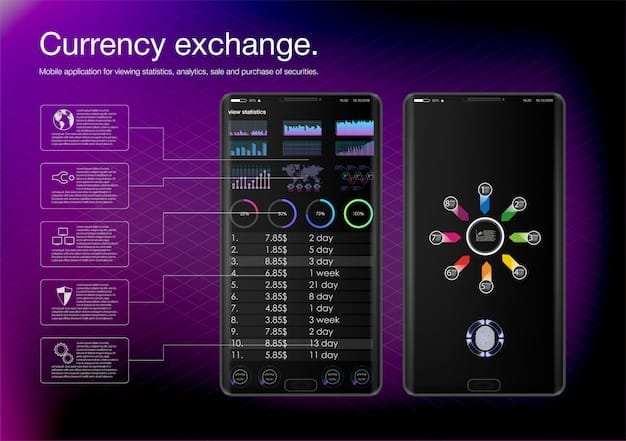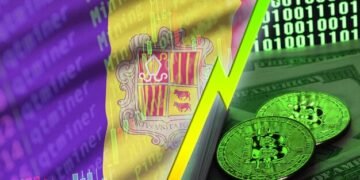Crypto Futures Contracts: A Beginner’s Guide to Leverage Trading

Understanding crypto futures contracts involves trading digital assets at a predetermined price and date, allowing investors to speculate on price movements, hedge their investments, and use leverage to amplify potential gains or losses.
Are you looking to dive into the world of cryptocurrency trading and explore advanced strategies? Understanding crypto futures contracts can open up new opportunities, but it’s crucial to grasp the fundamentals before you start leverage trading. In this beginner’s guide, we’ll break down everything you need to know.
What Are Crypto Futures Contracts?
Crypto futures contracts are agreements to buy or sell a specific cryptocurrency at a predetermined price on a future date. They allow traders to speculate on the future price of a cryptocurrency without actually owning it. This can be a powerful tool for both hedging and speculation, but it’s essential to understand the associated risks.
Unlike traditional spot trading, futures contracts involve leverage, which can magnify both profits and losses. Let’s delve deeper into the key components and benefits of crypto futures contracts.
Key Components of Futures Contracts
Understanding the key components of futures contracts is crucial for successful trading. Here are the main elements:
- Contract Size: The amount of cryptocurrency covered by a single futures contract.
- Expiration Date: The date on which the contract must be settled.
- Settlement Price: The price at which the contract is settled on the expiration date.
- Margin: The initial capital required to open a futures position.
These components work together to determine the potential risk and reward of a futures contract. Traders must carefully consider each element before entering a position.
Benefits of Trading Crypto Futures
Trading crypto futures offers several benefits, including:
- Leverage: Allows traders to control larger positions with less capital.
- Hedging: Enables traders to protect their existing cryptocurrency holdings from price declines.
- Two-Way Trading: Traders can profit from both rising and falling prices by going long or short.
Leverage, in particular, can significantly amplify potential profits, but it also increases the risk of substantial losses. Hedging strategies can provide a safety net, while two-way trading expands opportunities in different market conditions.

In summary, understanding the features and benefits of crypto futures contracts allows traders to strategically position themselves in the market, taking advantage of leverage and hedging opportunities.
Types of Crypto Futures Contracts
Crypto futures contracts come in various forms, each with unique characteristics and use cases. Understanding these different types can help traders select the contracts that best suit their trading strategies and risk tolerance.
The two primary types are perpetual futures and traditional futures. Let’s explore each in detail.
Perpetual Futures
Perpetual futures, as the name suggests, do not have an expiration date. Traders can hold these contracts indefinitely, as long as they maintain the required margin. A key mechanism of perpetual futures is the funding rate, which ensures that the contract price stays close to the spot price.
Perpetual futures are popular among traders due to their flexibility. The funding rate can be either positive or negative, depending on market conditions, and it is periodically exchanged between long and short position holders.
Traditional Futures
Traditional futures contracts have a specific expiration date, after which the contract must be settled. These contracts are more aligned with traditional financial markets and offer traders a clearer timeline for their positions.
Settlement of traditional futures contracts can occur in two ways: physical settlement, where the underlying cryptocurrency is delivered, or cash settlement, where the contract is settled in cash based on the settlement price. Cash settlement is more common in the crypto market.
Differences Between Perpetual and Traditional Futures
Here’s a comparison table to highlight the differences between perpetual and traditional futures:
- Expiration Date: Perpetual futures have no expiration date; traditional futures have a set expiration date.
- Funding Rate: Perpetual futures use a funding rate to keep the contract price close to the spot price; traditional futures do not.
- Settlement: Perpetual futures are typically settled in cash; traditional futures can be settled either physically or in cash.
Choosing between perpetual and traditional futures depends on a trader’s strategy and risk preferences. Perpetual futures offer more flexibility, while traditional futures provide a defined timeline.

In conclusion, understanding the nuances of perpetual and traditional futures contracts is essential for creating an appropriate trading strategy and mitigating risk.
Leverage and Margin in Crypto Futures
Leverage and margin are fundamental concepts in crypto futures trading, playing a critical role in amplifying both potential profits and potential losses. Understanding how they work is essential for managing risk effectively.
Leverage allows traders to control a larger position with a smaller amount of capital, while margin is the initial capital required to open and maintain that position.
Understanding Leverage
Leverage is expressed as a ratio, such as 1:10 or 1:50, indicating how much larger the position is compared to the trader’s capital. For example, with 1:10 leverage, a trader can control a position worth $10,000 with just $1,000 of capital.
While leverage can significantly increase potential profits, it also magnifies potential losses. It’s crucial to use leverage judiciously and implement risk management strategies to protect your capital.
Role of Required Margin
Margin serves as a security deposit to cover potential losses. There are two main types of margin: initial margin and maintenance margin. The initial margin is the amount required to open a position, while the maintenance margin is the minimum amount required to keep the position open.
If the trader’s account balance falls below the maintenance margin due to losses, a margin call is triggered, requiring the trader to deposit additional funds or risk having their position liquidated.
Managing Risks with Leverage and Margin
Effective risk management is essential when using leverage and margin. Here are some strategies to consider:
- Use Stop-Loss Orders: Automatically close your position if the price moves against you by a certain amount.
- Manage Position Size: Avoid overleveraging by limiting the size of your positions.
- Monitor Margin Levels: Keep a close eye on your account balance and margin levels to avoid margin calls.
By implementing these strategies, traders can mitigate the risks associated with leverage and margin, protecting their capital and maximizing their chances of success.
In summary, leverage and margin are powerful tools in the crypto futures market, but they must be used with caution and proper risk management to avoid substantial losses.
Risks Associated with Crypto Futures Trading
Crypto futures trading, while offering potential rewards, comes with significant risks that traders must understand and manage. These risks include market volatility, liquidation risk, and regulatory uncertainty.
Being aware of these risks and implementing risk management strategies is crucial for preserving capital and achieving long-term success.
Market Volatility
The cryptocurrency market is known for its extreme volatility, with prices often experiencing rapid and unpredictable swings. This volatility can amplify both profits and losses in futures trading, making it essential to use stop-loss orders and manage position sizes.
Traders should also stay informed about market news and events that could impact prices, adjusting their positions accordingly to mitigate potential risks.
Liquidation Risk
Liquidation occurs when a trader’s account balance falls below the maintenance margin, forcing the exchange to automatically close their position. This can result in significant losses, especially when using high leverage.
To avoid liquidation, traders should monitor their margin levels closely and be prepared to deposit additional funds if necessary. Using lower leverage can also reduce the risk of liquidation.
Regulatory Uncertainty
The regulatory landscape for cryptocurrencies and futures trading is still evolving, and changes in regulations can have a significant impact on the market. Traders should stay informed about regulatory developments and be prepared to adapt their strategies accordingly.
Uncertainty around regulations can create additional volatility and risk, making it essential to exercise caution and manage positions conservatively.
In conclusion, understanding and managing the risks associated with crypto futures trading is essential for protecting capital and achieving long-term profitability. Market volatility, liquidation risk, and regulatory uncertainty all pose significant challenges that traders must address.
Strategies for Trading Crypto Futures
Effective trading strategies are essential for navigating the crypto futures market successfully. These strategies include hedging, trend following, and range trading, each suited to different market conditions and trading styles.
By understanding and implementing these strategies, traders can improve their chances of success and manage risk effectively.
Hedging Strategies
Hedging involves taking a position in the futures market to offset potential losses in an existing cryptocurrency portfolio. For example, if you hold Bitcoin and are concerned about a potential price decline, you could open a short position in Bitcoin futures to protect your investment.
Hedging can reduce overall portfolio volatility and provide a safety net during market downturns.
Trend Following
Trend following involves identifying and trading in the direction of the prevailing market trend. This strategy is based on the idea that trends tend to persist for a period of time, allowing traders to profit by aligning their positions with the trend.
Trend following can be effective in both bull and bear markets, but it requires patience and discipline to avoid getting whipsawed during short-term corrections.
Range Trading
Range trading involves identifying cryptocurrencies that are trading within a defined price range and taking positions based on the expectation that the price will continue to fluctuate within that range. Traders buy near the bottom of the range and sell near the top.
Range trading can be profitable in sideways markets, but it requires careful monitoring and quick execution to capitalize on price movements.
In summary, implementing effective trading strategies is crucial for navigating the crypto futures market successfully. Hedging, trend following, and range trading each offer unique approaches to managing risk and capitalizing on market opportunities.
Getting Started with Crypto Futures Trading
Embarking on crypto futures trading requires careful preparation and a solid understanding of the market dynamics. Starting with the right steps can significantly improve your chances of success and reduce potential risks.
These steps include choosing a reputable exchange, understanding the trading interface, and starting with small positions.
Choosing a Reputable Exchange
Selecting a reliable and secure exchange is the first and most critical step. Look for exchanges with a proven track record, strong security measures, and a user-friendly interface.
Research the exchange’s regulatory compliance, customer support, and trading fees before making a decision. Popular exchanges include Binance, Coinbase, and Kraken, but it’s essential to do your own due diligence.
Understanding the Trading Interface
Familiarize yourself with the exchange’s trading interface, including how to place orders, set stop-loss orders, and monitor your positions. Most exchanges offer demo accounts or paper trading platforms where you can practice without risking real money.
Take the time to learn the different order types, such as market orders, limit orders, and stop orders, and how they can be used to manage your risk.
Starting with Small Positions
When you start trading, begin with small positions and low leverage to minimize potential losses. As you gain experience and confidence, you can gradually increase your position sizes and leverage.
Avoid the temptation to overleverage or take on too much risk early on. Patience and discipline are essential for long-term success in crypto futures trading.
In conclusion, getting started with crypto futures trading requires careful preparation and a disciplined approach. Choosing a reputable exchange, understanding the trading interface, and starting with small positions are crucial steps for minimizing risk and maximizing your chances of success.
| Key Point | Brief Description |
|---|---|
| 💡 Leverage | Magnifies potential profits and losses, requiring careful risk management. |
| 🛡️ Hedging | Protects against price declines by shorting futures. |
| 🗓️ Expiration | Distinguishes between perpetual and traditional futures contracts. |
| ⚠️ Risks | Volatility, liquidation, and regulatory uncertainty demand careful management. |
FAQ
▼
Spot trading involves buying and selling cryptocurrencies for immediate delivery, whereas futures trading involves contracts to buy or sell at a future date and price, often utilizing leverage.
▼
Leverage allows you to control a larger position with less capital. For example, 1:10 leverage lets you control a $10,000 position with $1,000. However, it amplifies both profits and losses.
▼
Key risks include high market volatility, liquidation risk (losing your margin), and regulatory uncertainty, which can affect market stability and trading conditions.
▼
A stop-loss order automatically closes your position when the price moves against you by a specified amount, helping to limit potential losses and protecting your capital.
▼
Look for exchanges with a strong track record, robust security measures, regulatory compliance, good customer support, and competitive trading fees. Research user reviews and consult industry experts.
Conclusion
Understanding crypto futures contracts and leverage trading can be a valuable skill for navigating the complex world of cryptocurrency investments. However, it’s crucial to approach this market with caution, implementing effective risk management strategies, and continuously educating yourself about market dynamics and regulatory developments.





